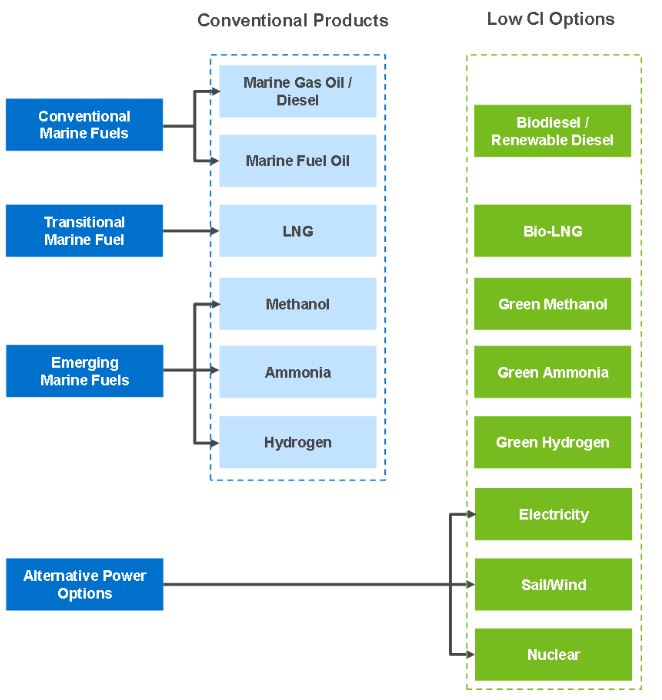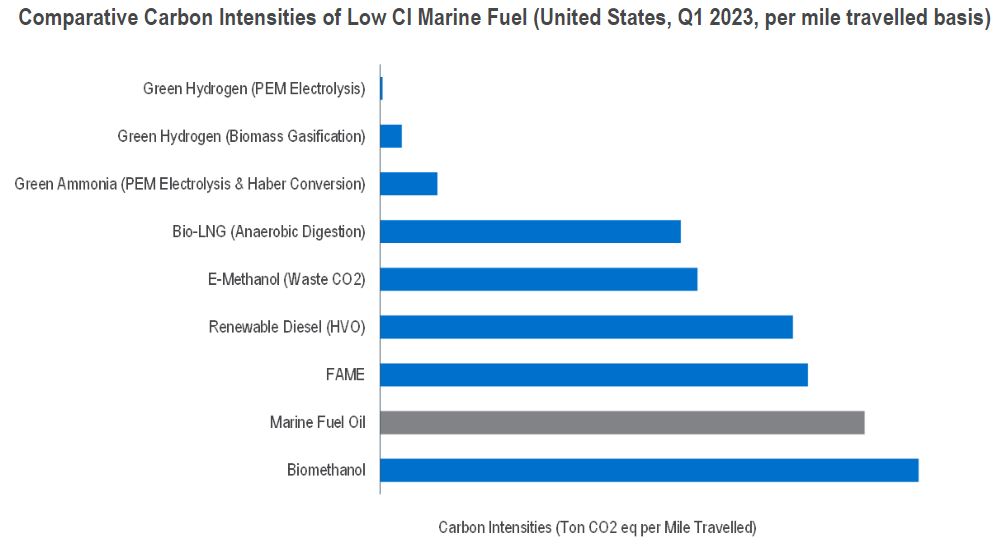Wave of change: Decarbonizing the maritime sector with low carbon intensity (CI) fuels

Decarbonization is becoming increasingly important to the global shipping industry. All materials need to be transported to and from production to market, thus shipping impacts the carbon footprint of all other sectors. Shipping companies, ship manufacturers, governments, industry organizations, and other players in the shipping and logistics value chain are following the general trend of decarbonization seen in other industry sectors.
According to the International Energy Agency (IEA), CO2 emissions from international shipping (essentially from bunker fuel consumption) were reported to be at 706 million tons in 2022, accounting for around two percent of global CO2 emissions. Without effective decarbonization measures, the shipping industry’s greenhouse gas (GHG) footprint is projected to grow up to 130 percent of 2008 levels by 2030.
In July 2023, the International Maritime Organization (IMO) adopted a revised GHG strategy to reduce GHG emissions from the shipping industry. The new targets include a 20 percent emissions reduction by 2030, a 70 percent reduction by 2040 (compared to 2008 levels), and the ultimate goal of achieving net zero emissions by 2050.
To date, the majority of cargo ships are still powered by marine fuel oil and diesel derived from crude oil, which emit relatively high CO2, SOx and NOx emissions when combusted. In recent years, liquefied natural gas (LNG) has emerged as a transition fuel between conventional marine fuels and cleaner alternatives due to its zero-sulfur content.
As part of the industry’s ongoing decarbonization efforts, alternative fuels that emit lower GHG emissions compared to conventional marine fuels are currently being developed. Renewable drop-in fuels such as biodiesel, Renewable Diesel, and bio-LNG are already seeing limited blended use as marine fuels. Fuels with relatively low or near-zero GHG emissions, such as methanol, ammonia, and hydrogen, are considered emerging marine fuels. The adoption of methanol remains limited to a small fraction of shipping vessels, while the use of ammonia and hydrogen is yet to be tested on actual commercial voyages.
Alternative power options such as electricity, wind and nuclear propulsion are also being explored as viable pathways toward net zero shipping. Technology development for these power options is still at a nascent stage, but some options like electricity and wind are already being adopted in hybrid drive systems that offer fuel-saving benefits for existing ships.
Power Options for Shipping Vessels
Decarbonizing the Maritime Sector with Low Carbon Intensity (CI) Fuels
NexantECA carried out a carbon intensity analysis on a per nautical mile basis for various low CI marine fuels produced in the United States, taking into account scope 1, scope 2, upstream scope 3, and downstream scope 3 fuel combustion emissions. The carbon intensities have been adjusted for gravimetric energy density, which is the amount of energy stored in a given mass of fuel. This adjustment facilitates the evaluation of the environmental performance of different fuel options for specific voyages.
The results show that green hydrogen and green ammonia rank among the marine fuels with the lowest overall carbon intensities. This is attributed to the utilization of renewable power, which has a considerably lower emission factor compared to conventional grid power generated using fossil fuels. In addition, fuel combustion emissions (categorized as downstream scope 3 fuel combustion emissions) for hydrogen and ammonia are considered zero as they do not emit CO2 at their point of consumption.
Other fuels such as bio-LNG, bio-methanol, e-methanol and biomass-based diesel (i.e., FAME and Renewable Diesel) have a higher carbon intensity than green hydrogen and green ammonia, as these are hydrocarbon fuels that still emit CO2 at their point of consumption, thereby contributing to significant downstream scope 3 fuel combustion emissions. Nonetheless, the majority of the fuels produced using renewable feedstocks and renewable power (except biomethanol) still offer emissions reduction benefits when compared to conventional marine fuel oil derived from crude oil.
Biomethanol has the highest carbon intensity on a per mile basis due to its relatively low gravimetric energy density compared to other fuels except ammonia. This means that ships are required to carry a larger quantity of biomethanol fuel to achieve the same endurance as compared to other marine fuels, contributing to a high carbon intensity on a per mile basis.
Carbon Intensities of Low CI Marine Fuel
Conventional routes to produce emerging lower-carbon marine fuels such as methanol, ammonia, and hydrogen still rely heavily on fossil fuels. Low carbon intensity (CI) options such as green methanol, green ammonia, and green hydrogen that are produced from renewable sources offer the potential towards zero-emissions shipping, though technology maturity and scalability of these low carbon processes need to be addressed for these options to be widely adopted in the shipping industry in the future.
The long-term goal is to switch from fossil to non-fossil based, low CI marine fuels produced with renewable or carbon-neutral sources. The development of low CI marine fuels, in combination with other decarbonization measures such as energy efficiency improvements in ships and onboard carbon capture, plays a critical role in achieving net zero emissions for the shipping industry by 2050.
Find out more…
Biorenewable Insights: Low Carbon Intensity Marine Fuels (2023 Program)
This report assesses low-carbon marine fuel technologies in terms of their technical, economic, and carbon intensity aspects, aligning with the International Maritime Organization (IMO)’s goals of reducing GHG emissions in the global maritime industry by at least 50 percent from 2008 levels by 2050 and achieving zero-emissions by 2100. Key technologies covered at the cost of production level on a per-ton and a per-mile basis include Renewable Diesel, Fatty Acid Methyl Esters (FAME), Renewable Natural Gas (RNG), MSW-based bio-methanol, e-methanol, green ammonia and green hydrogen. This report also presents a comparative analysis of the overall carbon intensity, considering scope 1, scope 2, upstream scope 3 and downstream scope 3 (fuel combustion) emissions across these fuel pathways.
The Authors…
Jia Lin Chong, Consultant
Li Vern Lim, Senior Analyst

